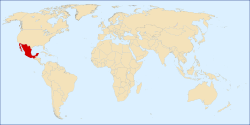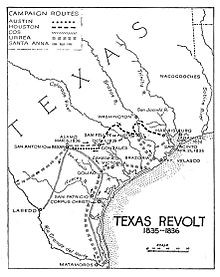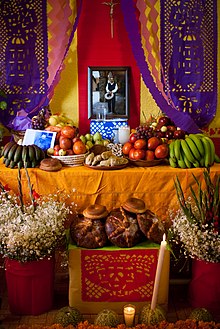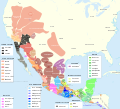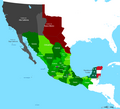Portal:Mexico
|
The Temple of Warriors at Chichen Itza, Mexico
¡Bienvenido! Welcome to the Mexico portal
Mexico, officially the United Mexican States, is a country in the southern portion of North America. It covers 1,972,550 km2 (761,610 sq mi), making it the world's 13th-largest country by area; with a population of almost 130 million, it is the 10th-most-populous country and the most populous Spanish-speaking country. Mexico is organized as a federal constitutional republic comprising 31 states and Mexico City, its capital. It shares land borders with the United States to the north, with Guatemala and Belize to the southeast; as well as maritime borders with the Pacific Ocean to the west, the Caribbean Sea to the southeast, and the Gulf of Mexico to the east.
This is a Featured article, which represents some of the best content on English Wikipedia.
The Texas Revolution (October 2, 1835 – April 21, 1836) was a rebellion of colonists from the United States and Tejanos (Hispanic Texans) against the centralist government of Mexico in the Mexican state of Coahuila y Tejas. Although the uprising was part of a larger one, the Mexican Federalist War, that included other provinces opposed to the regime of President Antonio López de Santa Anna, the Mexican government believed the United States had instigated the Texas insurrection with the goal of annexation. The Mexican Congress passed the Tornel Decree, declaring that any foreigners fighting against Mexican troops "will be deemed pirates and dealt with as such, being citizens of no nation presently at war with the Republic and fighting under no recognized flag". Only the province of Texas succeeded in breaking with Mexico, establishing the Republic of Texas. It was eventually annexed by the United States. The revolution began in October 1835, after a decade of political and cultural clashes between the Mexican government and the increasingly large population of Anglo-American settlers in Texas. The Mexican government had become increasingly centralized and the rights of its citizens had become increasingly curtailed, particularly regarding immigration from the United States. Mexico had officially abolished slavery in Texas in 1829, and the desire of Anglo Texans to maintain the institution of chattel slavery in Texas was also a major cause of secession. Colonists and Tejanos disagreed on whether the ultimate goal was independence or a return to the Mexican Constitution of 1824. While delegates at the Consultation (provisional government) debated the war's motives, Texians and a flood of volunteers from the United States defeated the small garrisons of Mexican soldiers by mid-December 1835. The Consultation declined to declare independence and installed an interim government, whose infighting led to political paralysis and a dearth of effective governance in Texas. An ill-conceived proposal to invade Matamoros siphoned much-needed volunteers and provisions from the fledgling Texian Army. In March 1836, a second political convention declared independence and appointed leadership for the new Republic of Texas. (Full article...)Selected article -The Day of the Dead (Spanish: el Día de Muertos or el Día de los Muertos) is a holiday traditionally celebrated on November 1 and 2, though other days, such as October 31 or November 6, may be included depending on the locality. It is widely observed in Mexico, where it largely developed, and is also observed in other places, especially by people of Mexican heritage. The observance falls during the Christian period of Allhallowtide. Some argue that there are Indigenous Mexican or ancient Aztec influences that account for the custom, and it has become a way to remember those forebears of Mexican culture. The Day of the Dead is largely seen as having a festive characteristic. The multi-day holiday involves family and friends gathering to pay respects and to remember friends and family members who have died. These celebrations can take a humorous tone, as celebrants remember funny events and anecdotes about the departed. Traditions connected with the holiday include honoring the deceased using calaveras and marigold flowers known as cempazúchitl, building home altars called ofrendas with the favorite foods and beverages of the departed, and visiting graves with these items as gifts for the deceased. The celebration is not solely focused on the dead, as it is also common to give gifts to friends such as candy sugar skulls, to share traditional pan de muerto with family and friends, and to write light-hearted and often irreverent verses in the form of mock epitaphs dedicated to living friends and acquaintances, a literary form known as calaveras literarias. (Full article...)Selected pictureThis is a Good article, an article that meets a core set of high editorial standards.
Hasta la Raíz (transl. To the Root) is the fifth studio album by Mexican recording artist Natalia Lafourcade, released on March 17, 2015, through Sony Music Mexico. After the success of her previous album, Mujer Divina – Homenaje a Agustín Lara (transl. Divine Woman – A Homage to Agustin Lara), a tribute to Mexican singer-songwriter Agustín Lara, Lafourcade decided to record an album with original recordings. Lafourcade spent three years writing the songs and searching for inspiration in different cities, resulting in songs that express very personal feelings regarding love. The record was produced by Lafourcade, with the assistance of Argentinian musician Cachorro López and Mexican artist Leonel García. Upon its release, Hasta la Raíz received favorable reviews from music critics, with some critics expressing skepticism about her songwriting and saying she had stayed within her comfort zone, and others praising her evolution as a musician and naming the album one of the best pop releases of the year. The record peaked at number eight in the US Billboard Latin Albums and number one in Mexico, where it was certified double platinum and gold, with over 150,000 copies shipped in the country. Hasta la Raíz received a nomination for Album of the Year and won Best Alternative Music Album and Best Engineered Album at the 16th Latin Grammy Awards. The album also won Best Latin Rock, Urban or Alternative Album at the 58th Annual Grammy Awards. (Full article...)Selected biography -José de la Cruz Porfirio Díaz Mori GCB (/ˈdiːəs/ DEE-əss or /ˈdiːæz/ DEE-az; Spanish: [poɾˈfiɾjo ði.as]; 15 September 1830 – 2 July 1915), known as Porfirio Díaz, was a Mexican general, politician, and later dictator who served seven terms as President of Mexico, a total of 35 years, from 28 November 1876 to 6 December 1876, 17 February 1877 to 1 December 1880, and 1 December 1884 to 25 May 1911. The entire period from 1876 to 1911 is often referred to as the Porfiriato, and has been characterized as a de facto dictatorship. Díaz was born to an Oaxacan family of modest means. He initially studied to become a priest, but eventually switched his studies to law, and among his mentors was the future President of Mexico, Benito Juárez. Díaz increasingly became active in Liberal Party politics fighting with the Liberals to overthrow Santa Anna in the Plan of Ayutla, and also fighting on their side against the Conservative Party in the Reform War. (Full article...)
In the news
Selected fare or cuisine -Mole (Spanish: [ˈmole]; from Nahuatl mōlli, Nahuatl: [ˈmoːlːi]), meaning 'sauce', is a traditional sauce and marinade originally used in Mexican cuisine. In contemporary Mexico the term is used for a number of sauces, some quite dissimilar, including mole amarillo or amarillito (yellow mole), mole chichilo, mole colorado or coloradito (reddish mole), mole manchamantel or manchamanteles (tablecloth stainer), mole negro (black mole), mole rojo (red mole), mole verde (green mole), mole poblano, mole almendrado (mole with almond), mole michoacano, mole prieto, mole ranchero, mole tamaulipeco, mole xiqueno, pipián (mole with squash seed), mole rosa (pink mole), mole blanco (white mole), chimole, guacamole (mole with avocado) and huaxmole (mole with huaje). Generally, a mole sauce contains fruits, nuts, chili peppers, and spices like black pepper, cinnamon, or cumin. (Full article...)
General imagesThe following are images from various Mexico-related articles on Wikipedia.
CategoriesTopicsRelated portalsWikiProjectYou are invited to participate in WikiProject Mexico, a WikiProject dedicated to developing and improving articles about Mexico. Associated WikimediaMore portals | ||||||||||




